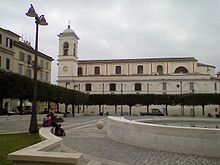Suburbicarian Diocese of Albano
|
Suburbicarian Diocese of Albano Albanensis |
|
|---|---|

Albano Laziale Cathedral
|
|
| Location | |
| Country | Italy |
| Ecclesiastical province | Rome |
| Statistics | |
| Area | 661 km2 (255 sq mi) |
| Population - Total - Catholics |
(as of 2012) 505,500 (est.) 470,300 (est.) (93.0%) |
| Parishes | 77 |
| Information | |
| Denomination | Catholic Church |
| Rite | Roman Rite |
| Established | 4th century |
| Cathedral | Basilica Cattedrale di S. Pancrazio Martire |
| Secular priests | 104 (diocesan) 80 (Religious Orders) |
| Current leadership | |
| Pope | Francis |
| Bishop | Marcello Semeraro |
| Emeritus Bishops |
Dante Bernini Paolo Gillet (Auxiliary Bishop Emeritus) |
| Map | |
 |
|
| Website | |
| www.webdiocesi.chiesacattolica.it | |
The Diocese of Albano (Latin: Albanensis) is a suburbicarian see of the Roman Catholic Church in a diocese in Italy, comprising seven towns in the Province of Rome. Albano Laziale is situated some 15 kilometers from Rome, on the Appian Way.
Under current arrangements it has both a titular bishop and a diocesan bishop.
In the very year of his consulate, Acilius Glabrio was compelled by Domitian to fight, unarmed, in the amphitheatre at Albano, a Numidian bear, according to Juvenal: an enormous lion, according to Dio Cassius. This same Acilius Glabrio is later included in a Christian group of the Flavian family as a molitor rerum novarum. The Liber Pontificalis under the name Silvester says:
This basilica of the time of Constantine was destroyed by fire toward the end of the 8th century or in the beginning of the ninth Ferdinando Franconi has established the identity of this basilica with the present Albano Cathedral, which still contains some remains of the edifice dedicated by Pope Leo III to Saint Pancras. Under the basilica there was a crypt, or confessio, from which bodies were transferred to the cemetery nearby.
The foundation of the episcopal see of Albano is very probably contemporaneous with the erection of the Constantinian basilica. However, the first bishop of the see of whom we have any knowledge is Dionysius (d. 355). It is more than a century later (463) that we meet with another Bishop of Albano, Romanus. To these is to be added Ursinus, whose name is found on an inscription in the Catacomb of Domitilla. The consular date is either 345 or 395. The importance of this early Christian community is apparent from its cemetery, discovered in 1720 by Marangoni. It differs but little from the Christian cemeteries found in Rome. Its plan, clearly mapped out in the Epitome de locis ss. martyrum quae sunt foris civitatis Romae, is considered by Giovanni Battista de Rossi as the synopsis of an ancient description of the cemeteries, written before the end of the 6th century:
...
Wikipedia
